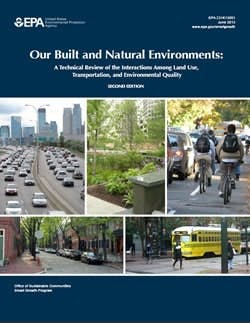Report Details How Development Impacts Public Health, Environment
The U.S. Environmental Protection Agency (EPA) released its most comprehensive review to date on how the built environment — the way we build our cities and towns – directly affects our environment and public health. The report was announced by EPA Acting Administrator Bob Perciasepe during a national Twitter Town Hall meeting in Washington, D.C., with Maurice Jones, deputy secretary of the U.S. Department of Housing, and Development (HUD), and John Porcari, deputy secretary of the U.S. Department of Transportation (DOT).
The publication, Our Built and Natural Environments: A Technical Review of the Interactions among Land Use, Transportation, and Environmental Quality, provides evidence that certain kinds of land use and transportation strategies — where and how we build our communities — can reduce the environmental and human health impacts of development.
The report summarizes trends in land use, buildings, travel behavior, population growth and the expansion of developed land. It then discusses the environmental consequences of these trends, such as habitat loss, degradation of water resources and air quality, urban heat islands, greenhouse gas emissions and global climate change, and other health and safety effects. Environmental impacts linked to building and development patterns include:
- At least 850,000 acres of lakes, reservoirs, and ponds and 50,000 miles of rivers and streams are thought to be impaired by storm water runoff.
- Although technology has reduced per-car vehicle emissions, an approximate 250% increase in vehicle miles travelled since 1970 has offset potential gains.
- Transportation is responsible for 27% of U.S. greenhouse gas emissions; residential and commercial buildings contribute 18% and 17%, respectively.
The report concludes by describing ways to reduce such effects. Strategies include safeguarding sensitive areas; focusing development in built-up areas and around existing transit stations; building compact; mixed-use developments; designing streets that are safe for all users, including walkers and bikers; and using green building techniques.
This report will be useful for communities across the country looking to make smart development decisions,” said EPA Acting Administrator Bob Perciasepe. “Whether it’s housing, transportation, or environmental issues, this report can help communities protect public health and the environment by avoiding harmful development strategies.”
Source: EPA


